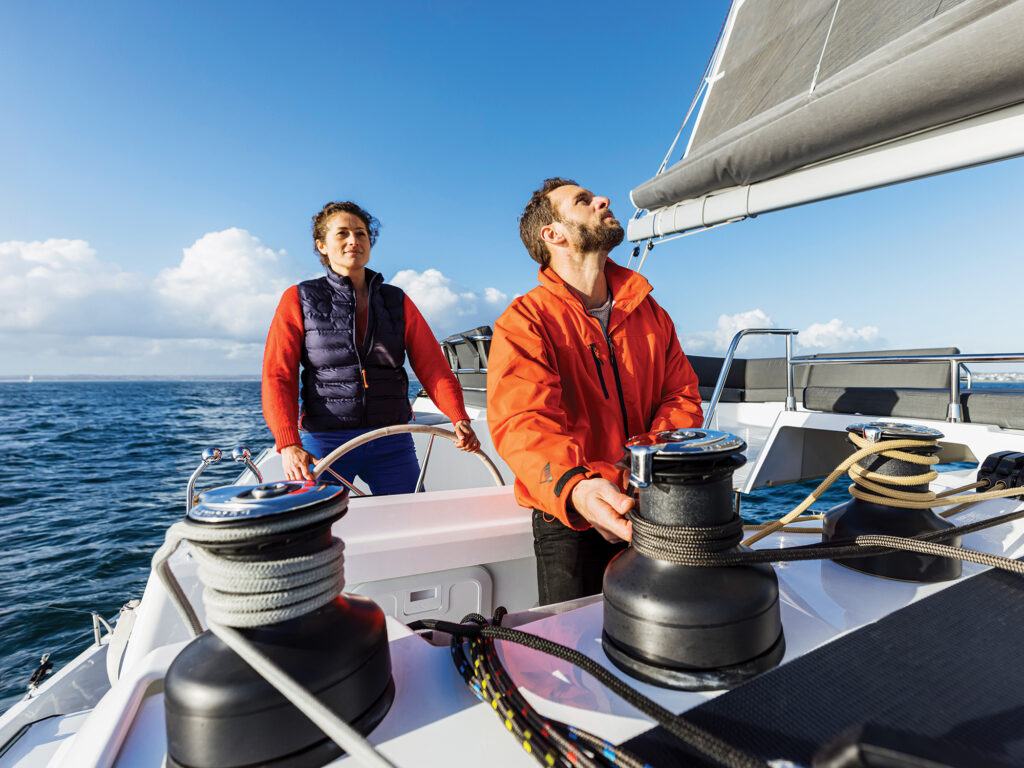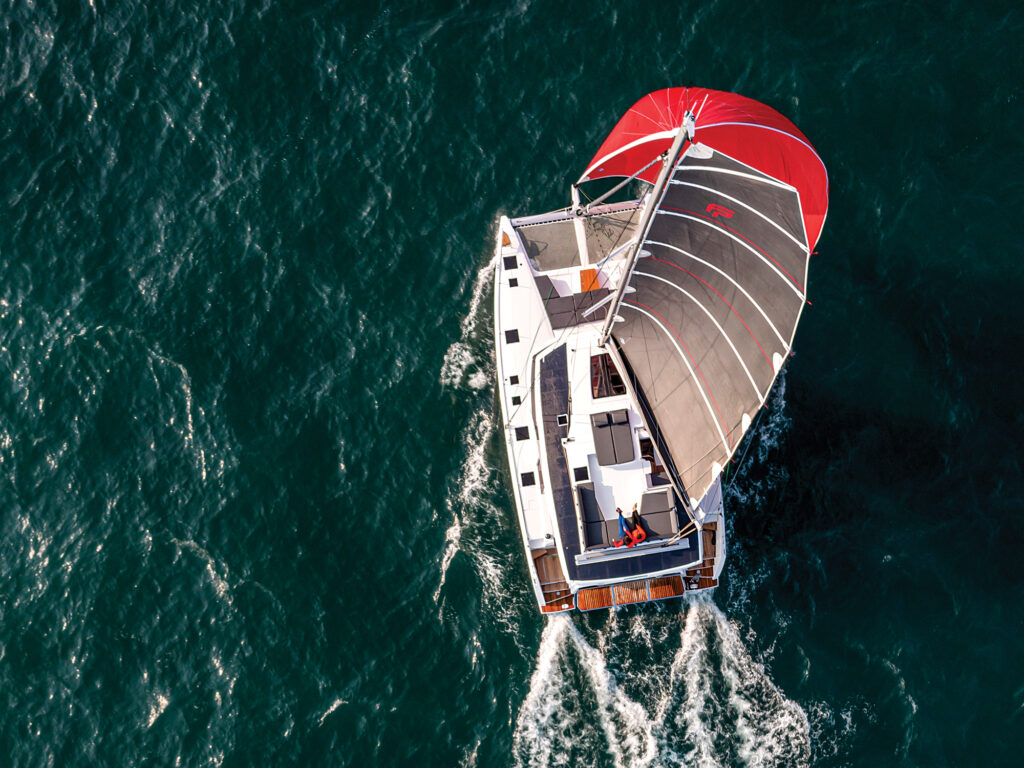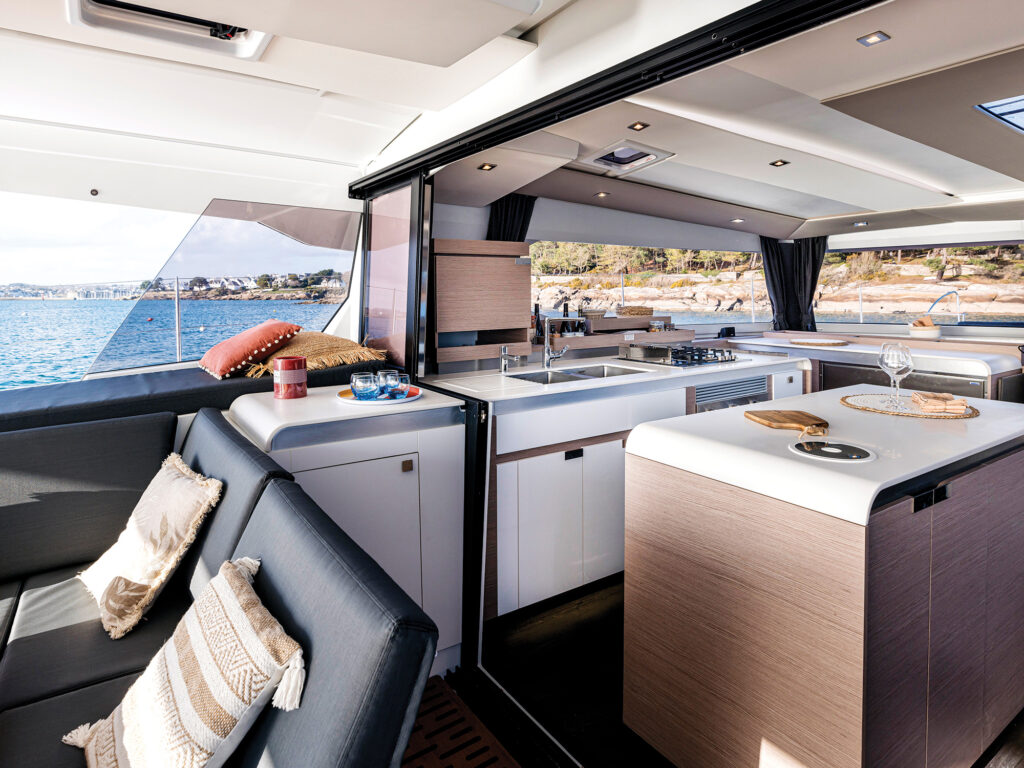
A funny thing has happened in the evolution of cruising catamarans. The category, at the outset, was defined by straightforward simplicity. This was true going back to the double-hulled Polynesian voyaging canoes, through the iconic designs of the visionary James Wharram, on to the custom cats built on Caribbean beaches by Peter Spronk, and including the early production cats of the modern era from Fountaine Pajot and Lagoon. Cruising catamarans were basically a pair of narrow hulls with a rather minimalistic living and working space sandwiched between them.
It wasn’t too long before builders and designers realized that if they added a bit of volume to those hulls and stretched them, they could fill them with comfortable double-berth staterooms, en suite heads and other amenities. And, thanks largely to the catamaran’s emergence as an excellent platform for bareboat charter, designers could also make them taller (the “wedding-cake effect”). That brought us not only upper-deck lounges with day beds, grills and refrigerators, but also dedicated flybridges with steering stations that were once the exclusive domain of trawlers and sport-fishing craft.
Everything’s gotten bigger these days. Certainly, here in my hometown of Newport, Rhode Island, and in nearby destinations including Long Island, Cape Cod and Nantucket, modest seaside homes have been razed to make room for garish mansions with gyms, pools and astronomical square footage. In contemporary cruising cats, I’m feeling comparable vibes.
As a judge for the 2024 Boat of the Year awards, I was struck by the technology, sophistication and similarities of the contestants vying for Best Cruising Catamaran Over 50 Feet. Both were from French builders, both were 51 feet, and both had seven-figure price tags. The Lagoon 51 was a very different beast than the first Lagoon I ever stepped aboard, the compact Lagoon 37. And the winning boat, the Fountaine Pajot Aura 51, was a far cry from the basic Louisiane 37 that launched the company’s foray into cruising cats back in 1983.

Fountaine Pajot has certainly placed a big bet on the Aura 51, as it’s replacing the Saba 50, of which some 300 hulls were sold. Describing the overall aesthetic by Berret-Racoupeau Design is no simple task. The lines are actually pretty sweet for a gargantuan 51-footer with a beam of more than 25 feet. As with all contemporary cats, the waterline is maxed out, with a plumb bow and an extended boarding step in the squarish transom. The hull windows and the wraparound window treatment in the coachroof complement each other well.
Clearly, the goal was to optimize comfort at anchor. There are cushioned seats in the forward deck, just abaft the trampolines. What the company calls the “sky lounge” is topside on the roof of the Bimini hardtop over the cockpit, with a 2,000-watt array of solar panels sharing this space.
The steering wheel is to starboard, a few steps up from the cockpit, putting the skipper in a strategic location to communicate with mates on the lower or upper level, which is another four steps up from the wheel. Everything’s a compromise when it comes to boats, and the drawback here is that there are blind spots to port, particularly if coming along a portside berth. You’re going to want a mate calling out the distance. (There is no flybridge wheel.)
That said, I’m actually a big fan of the split steering station, with the wheel, engine controls and Garmin instruments on a pedestal under a canvas Bimini top, and a trio of Lewmar self-tailing electric winches, a pair of Spinlock rope clutches, and all the running rigging led to a dedicated pod just forward of the helmsman. This is a signature Fountaine Pajot feature on several models. Frankly, with imitation being the sincerest form of flattery, I’m surprised more builders have not adopted this layout. It really does allow for solo sailing; the driver can put the boat on autopilot, slip a couple of steps forward, and trim and reef to the heart’s delight.
Unfortunately, for our sea trial on Chesapeake Bay, we didn’t have the double-digit windspeeds needed to put the Aura 51 through its proper paces, but the boat moved well in the 5- to 8-knot northerly, making over 4 knots closehauled, and an even 4 when cracked off on a beam reach. A company rep suggested that in better breeze, the boat would generally make speeds about half that of the true-wind pressure. There’s an optional bowsprit arrangement with all the associated hardware to set a code-zero-style headsail.
There certainly is no lack of sail area, particularly the square-topped full-battened mainsail that’s set off a whopping 76-foot spar. We see quite a few sails from French sailmaker Incidence on French-built boats, like the ones on our test ride, and they are always top-notch. The boat we tested also had optional twin 75 hp Volvo Pentas with saildrives (60 hp engines are standard). The boat galloped along at over 8 knots at 2,400 rpm. Decibel-wise, it was one of the quietest in the entire 2024 Boat of the Year fleet. The composite construction is a rather straightforward combination of resin injection and infusion with balsa core in the hulls and Divinycell foam in the deck.

All of which brings us to the vessel’s true raison d’être: the open floor plan with condolike cabins and accommodations, which are impressive.
The sliding doors separating the main cabin and cockpit can be fully opened. The main dining table is in the cockpit and can be fully enclosed with canopies. The straight-line galley is inside and to port, bordered by an island that doubles as counters and a workspace for the cook. There’s plenty of seating, and the views through the coachroof windows are terrific. Surprisingly, there is no dedicated navigation station, which to me seems like an oversight on a boat of this size.
Several layouts are available. Our test model had the “double maestro”: a master stateroom aft in each hull, accessed from the interior or through a pair of gullwing doors in the cockpit. Guest staterooms are forward. Boat of the Year judge Mark Pillsbury noted that this could be a nice setup for two owners to share, whether sailing separately or together. Regarding our choice of the Aura 51 over the Lagoon for Boat of the Year, our panel collectively felt that both boats would do well in charter, but that the Aura was better suited to real cruising as opposed to being aimed more toward vacation sailing.
No pun intended, but there’s a definite aura to this rangy cat that separates it from the other models that Fountaine Pajot produces. This is a boat meant to be lived on and in, for extended periods, in high comfort bordering on true luxury. Bring friends and family. On the Aura 51, there is definitely room for the whole gang.
Herb McCormick is a CW editor at large and was a 2024 Boat of the Year judge.
Did You Know?
■ Fountaine Pajot is pioneering a “zero-emission energy system” in the Aura 51. The Smart Electric version of the boat incorporates electric motors, folding props, solar panels, a generator, and a pair of lithium-ion battery banks capable of storing 54 kilowatt hours. Under sail via hydrogeneration, the system can recharge the batteries in 48 hours.
■ Founded in 1976 by a quartet that included Olympic sailor Jean-François Fountaine and offshore racer Yves Pajot, Fountaine Pajot specialized at the start in racing dinghies and IOR-rule monohulls. The company later delved into large, record-setting transoceanic catamarans and trimarans. It wasn’t until 1983 that the yard pivoted to cruising cats, beginning with the Louisiana 37.
■ During the past four decades, Fountaine Pajot has produced more than three dozen models, many named after the destinations or islands that inspired them: Tobago 35, Saba 50, Eleuthera 60 and so on. Today, the company also includes Dufour Yachts, a range of power cats, and eight cruising/sailing cat models from 40 to 80 feet.








